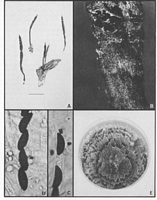|
 Xylaria arbuscula Xylaria arbuscula
BiostatusPresent in region - Indigenous. Non endemic
Images (click to enlarge)
Caption: Fig. 9 Xylaria arbuscula A, Stromata. B, Stromal surface. C, Ascal ring and ascospores
(Melzer's reagent). D, Ascospores with germ slits (Melzer's reagent) E, Colony on OA
(PDD 43204; Lines A = 1 cm; C, D = 10 µm). |
Description: Stromata: Stromata upright (taller than broad), or filiform; stipitate; 20-40 mm tall; 2-3 mm diam.; perithecia not visible; ostioles lower than or more or less equal to stromatal surface; stromatal surface wrinkled, or more or less smooth; dark brown (brown vinaceous), or blackish; KOH-extractable pigments lacking; tissue below perithecia conspicuous, essentially homogeneous, white.
Perithecia: Perithecia more or less globose; 0.3-0.4 mm diam.
Asci: Stipe long with spores more or less confined to upper half of ascus; amyloid ring higher than broad.
Ascospores: Ascospores 13-16 µm long; 5-6 µm wide; brown; -septate; in side view inequilateral, flattened on one side, curved; in face view elliptic; ends narrowly rounded. Germ slit straight, spore-length; on flattened side of spore. Perispore indehiscent in 10% KOH.
Article: Rogers, J.D.; Samuels, G.J. (1987) [1986]. Ascomycetes of New Zealand 8. Xylaria. New Zealand Journal of Botany 24(4): 615-650 (http://www.rsnz.org/publish/abstracts.php).
Description: Stromata solitary to gregarious, unbranched or rarely branched near base and then
fasciculate, (1-)2-3(-4) cm long; fertile portion lanceolate, circular to elliptic in section, 2-3
mm diam.; stipe to 10 mm long x 1.0-1.5 mm diam., not sharply delimited from fertile
portion, slightly wrinkled, glabrous or with fine brown hairs; at first with a cinereous
coating on surface of stroma, the cinereous colouration eventually disappearing and then
stromal surface becoming black, smooth or slightly wrinkled; peritheeia completely
immersed, 300-400 µm diam., each opening through an inconspicuous papilla; internal
tissue of stroma solid, white. Asci 150-210 µm total length x 5-9 µm, the sporiferous part
65-100 µm, cylindrical; apical ring J +, cylindrical, 2-3 µm wide x 3-4 µm high; asci 8-spored,
ascospores uniseriate with overlapping ends. Ascospores (11-)13-16(-19) x (4.0-)5.0-6.0(-7.5) µm,
inequilateral with one side flat and one side curved; elliptic in top view;
one-celled or with inconspicuous cellular appendage (primary appendage) on one end,
transparent brown; slit full length or less than full length and then 7-12 µm long, diagonally
inserted, or parallel to long axis of ascospore, straight or broadly sigmoidal.
CHARACTERISTICS IN CULTURE: Colonies grown three weeks at 20°C in diffuse
daylight on OA 5 cm diam., with pronounced concentric rings of slightly raised, yellow-tan
to orange-tan mycelium alternating with broader bands of appressed white mycelium.
Stromata not forming in culture.
Habitat: HABITAT: On bark and decorticated wood of angiosperms and gymnosperms but not
found in Nothofagus forests.
Distribution: DISTRIBUTION: (number of specimens examined in parentheses). NORTH ISLAND:
Northland (5), Auckland (13), Wanganui (1), Wellington (3). SOUTH ISLAND: Nelson
(1), Southland (1).
Notes: Xylaria arbuscula was originally described from a greenhouse in Italy and has
since been reported from various parts of the world. Dennis (1956) has listed probable
synonyms and, later (Dennis 1961) accepted it as Xylosphaera mellisii (Berk.) Dennis [=
Xylaria mellisii (Berk.) Cooke]. Because of the probability that several taxa will eventually
be recognised (see below) we accept the better known name until additional studies can be
done. Miller's description (1942) of X. arbuscula from Africa generally embraces our
concept of the species.
Xylaria arbuscula from New Zealand is characterised by a thin, cinereous coating
overlying the dark underlying stroma. This coat often disappears almost completely from
older specimens. The ascospore germ slit is usually broadly sigmoidal, laterally inserted,
and less than the full length of the ascospore. Ascospores sometimes bear a very
inconspicuous cellular (primary) appendage on one end. The frequency of appendaged
ascospores varies from collection to collection. Stromata from North µmerica, South
µmerica and Europe usually show a more conspicuous cinereous or light tan outer layer
which dehisces by shredding or peeling; ascospore germ slits are usually less than the full
length of the ascospore and, in some cases, ascospores bear an inconspicuous cellular
appendage (J. D. Rogers unpublished).
Cultures were made from four collections of X. arbuscula from New Zealand but these did
not form stromata and remained sterile. Martin (1970) cultured X. arbuscula from Africa
and reported only sterile stromata.
|